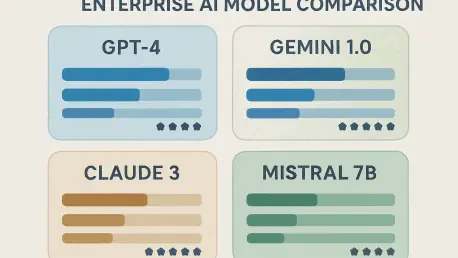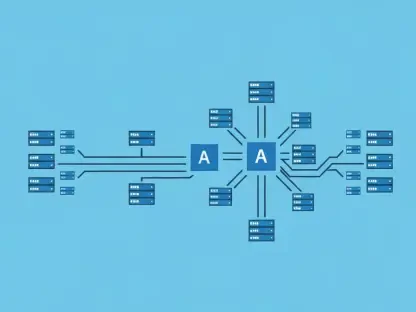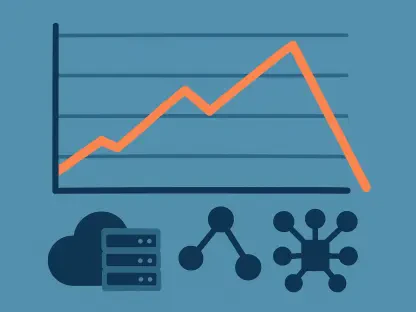What if the future of a business hinges on a single tech decision—one that could redefine efficiency, customer trust, and competitive edge? In today’s enterprise landscape, large language models (LLMs) like Databricks DBRX, OpenAI GPT-4o, and Anthropic Claude 3 are not mere tools; they are transformative forces. With AI adoption skyrocketing—studies indicate over 60% of Fortune 500 companies now leverage such technologies for core operations—the choice of model becomes a strategic cornerstone. This exploration unpacks the strengths of these three powerhouses, guiding enterprises through the maze of options to pinpoint the best fit for their unique challenges.
Why the Right AI Model Can Redefine Business Outcomes
The stakes of AI integration in corporate settings have never been higher. Enterprises are racing to harness these technologies for everything from automating repetitive tasks to generating actionable insights from vast datasets. However, a misstep in selecting an LLM can drain budgets, expose vulnerabilities, or stall innovation. The differences among DBRX, GPT-4o, and Claude 3 lie in their design philosophies and target applications, making a tailored choice paramount for maximizing return on investment.
Beyond financial implications, the right model can reshape how a company interacts with its market. Whether it’s enhancing customer service through real-time responses or ensuring compliance in regulated sectors, the impact of AI extends to brand reputation and operational resilience. This critical junction demands a deep dive into what each model offers, ensuring alignment with specific enterprise goals and industry demands.
Unpacking the Core Strengths for Enterprise Needs
A closer look at DBRX, GPT-4o, and Claude 3 reveals distinct advantages across vital business dimensions. Customization is a key battleground: DBRX, with its open-source framework, empowers companies with the technical know-how to fine-tune solutions to precise specifications. In contrast, GPT-4o prioritizes speed through an API-driven approach, enabling seamless integration without heavy setup. Claude 3 bridges these extremes, offering reliable performance straight out of the box with a focus on safety and accuracy.
Industry fit further differentiates these models. DBRX thrives in data-intensive fields like finance and logistics, leveraging its integration with the Databricks ecosystem for robust analytics. GPT-4o’s multimodal capabilities—handling text, audio, and visuals—make it a go-to for retail and media, where customer engagement is key. Meanwhile, Claude 3 stands out in legal and healthcare sectors, where its emphasis on compliance and precision handles sensitive tasks with finesse.
Cost and performance round out the comparison. DBRX slashes long-term expenses with no licensing fees, though it demands upfront technical investment. GPT-4o’s API costs are balanced by rapid deployment and workflow gains, often yielding quick returns. Claude 3, while less versatile in multimedia, delivers high-quality outputs that cut down on errors, proving cost-effective in environments where accuracy is paramount.
Voices from the Trenches: Real-World Feedback
Insights from those already using these models add depth to the evaluation. A tech strategist in the financial sector praised DBRX for its transparency, noting, “The open-source access lets us audit every layer, which is critical for data security.” This level of control resonates with firms handling sensitive information, where trust in AI systems is non-negotiable.
GPT-4o garners acclaim for its adaptability, especially in dynamic industries. A retail chain executive shared, “We rolled out a voice-assisted shopping tool in weeks, boosting engagement by 40%.” Such feedback highlights how the model’s speed and multimodal features translate directly into measurable business impact, particularly for customer-facing applications.
Claude 3, on the other hand, wins trust in regulated spaces. A healthcare administrator emphasized, “Its cautious approach to data interpretation aligns with patient privacy laws, reducing our risk.” This focus on ethical AI and contextual depth makes it a preferred choice for sectors where mistakes carry heavy consequences, as echoed by multiple user testimonials and industry reports.
Matching the Model to Industry Demands
Each model carves out a niche when aligned with specific enterprise contexts. For a manufacturing giant wrestling with supply chain analytics, DBRX’s ability to integrate with existing data platforms offers a clear path to optimized reporting and forecasting. Its open architecture allows for bespoke adjustments that proprietary systems often can’t match.
In contrast, a media company aiming to personalize content at scale finds GPT-4o’s strengths irresistible. The model’s capacity to process diverse inputs—think video scripts alongside customer feedback—enables rapid creation of targeted campaigns. This versatility ensures that businesses in fast-moving sectors stay ahead of trends without overhauling their infrastructure.
For organizations in high-stakes fields like government contracting, Claude 3 emerges as a reliable partner. Its knack for digesting lengthy policy documents in one go, coupled with low error rates, supports decision-making where precision is paramount. Such alignment with sector-specific priorities underscores the importance of matching AI capabilities to operational realities.
Charting the Path to the Best AI Fit
Navigating the decision between DBRX, GPT-4o, and Claude 3 calls for a methodical approach. Begin by defining core objectives—whether the focus is on deep customization, rapid rollout for market-facing tools, or stringent ethical standards for sensitive data. This clarity helps narrow the field, pointing toward the model that best addresses immediate and long-term needs.
Next, assess internal resources and financial constraints. Enterprises with robust tech teams might lean toward DBRX for its cost-saving potential over time, while those needing instant results could justify GPT-4o’s subscription fees for quicker gains. Claude 3 appeals when quality output outweighs budget concerns, especially in industries where rework costs more than initial investment.
Finally, pilot testing offers invaluable insights. Deploy DBRX for a data-crunching project, trial GPT-4o in a customer interaction app, or evaluate Claude 3 on compliance documentation. Observing real-time performance in relevant scenarios ensures the chosen model not only fits on paper but also delivers under pressure, paving the way for informed scaling.
Reflecting on the AI Journey and Next Steps
Looking back, the journey through the capabilities of DBRX, GPT-4o, and Claude 3 reveals a landscape rich with potential, tailored to diverse enterprise challenges. Each model carves a distinct path, from open-source empowerment to multimodal innovation and ethical precision, shaping how businesses tackle their toughest problems.
As companies move forward, the emphasis shifts to actionable integration. Conducting small-scale trials emerges as a prudent step, allowing firms to validate model performance against specific workflows. Simultaneously, staying attuned to evolving AI advancements promises to refine strategies, ensuring adaptability in a fast-changing tech arena.
Ultimately, the focus turns toward building hybrid frameworks. Combining strengths—perhaps DBRX’s customization with GPT-4o’s speed or Claude 3’s safety—offers a vision for comprehensive solutions. This forward-thinking approach positions enterprises to not just adopt AI, but to wield it as a catalyst for sustained growth and innovation.









